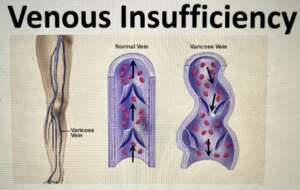Chronic Venous Insufficiency
Learn about chronic venous insufficiency, its causes, symptoms, and effective treatment options.
Chronic Venous Insufficiency
Typically slow and progressive circulation disorder
Deep vein thrombosis (DVT)
Varicose veins
Chronic venous insufficiency‐faulty valves

Chronic venous insufficiency. This refers to insufficient venous return. It is an advanced stage of venous disease where the veins and muscles involved in pumping activities become incompetent. Venous insufficiencies affect the lymphatic system. This occurs when the venous wall and/or valves in the leg are not working properly, causing blood to pool in the legs, resulting in swelling
Chronic Venous Insufficiency won’t get better if left untreated and can become very serious, potentially leading to venous stasis ulcers.

Who is At Risk for Chronic Venous Insufficiency?
- Deep Vein Thrombosis (DVT)
- Varicose veins or a family history of varicose veins / CVI
- Obesity
- Smoking
- Pregnancy
- Inactivity
- Prolonged periods of sitting or standing
- Female sex
- Age over 50
Who is At Risk for Chronic Venous Insufficiency?
- Deep Vein Thrombosis (DVT)
- Varicose veins or a family history of varicose veins / CVI
- Obesity
- Smoking
- Pregnancy
- Inactivity
- Prolonged periods of sitting or standing
- Female sex
- Age over 50
What are Symptoms of Chronic Venous Insufficiency?
- Swelling in the lower legs, especially after prolonged sitting or standing
- New varicose veins
- Aching, heaviness, or tiredness in the legs
- Flaky or itchy skin of the legs
- Skin of the legs appears leathery
- Venous stasis ulcers
Is Chronic Venous Insufficiency Treatable?
Yes, it can be treated with Compression stockings, exercising regularly and Complete Decongestive Therapy/Manual Lymphatic drainage Vodder technique
Also, you should:
Avoid extended periods of standing or sitting
Elevate your legs while lying down or sitting (so that your legs are above your heart)
Lose weight if you are overweight
Antibiotics or medicine (to treat infection)
Practice good skin hygiene
Non-surgical treatment (i.e., sclerotherapy or endovenous thermal ablation)
Surgical treatment (i.e., ligation and stripping, microincision / ambulatory phlebectomy, or vein bypass)
While anyone may develop CVI in their life, several risk factors increase the probability of developing it.
Symptoms of Chronic Venous Insufficiency can include:
Fatigue or heaviness in the legs, especially at the end of the day
Swelling‐bilateral typically
Restless legs
Hyper‐pigmentation of skin, skin color, and texture changes
Formation of visible veins on the legs and sores that don’t heal quickly
If you notice any of these symptoms or suspect that you may have CVI, please consult with your medical professional.
Chronic Venous Insufficiency has a variety of treatment options available, depending on the stage of the condition:
- Complete Decongestive Therapy (CDT) is used primarily in the treatment of lymphedema and Venous Insufficiency edema.
- Manual Lymphatic Drainage in conjunction with a compression garment,
- A good, healthy, balanced diet and exercise can help control the progression of Lymphedema, lipedema, and the control of the edema in CVI.
There is no cure for Lymphedema, Lipedema, or CVI conditions. Still, doctors specialized in the lymphatic system and scientific research suggest the importance and the impact of Manual lymphatic drainage MLD/CDT in the management of the condition’s progression.
Tables and pictures courtesy of the book Lymphedema Management, the Comprehensive Guide for Practitioners. Joachim E. Zuther & Steve Norton

